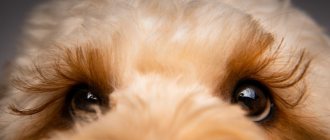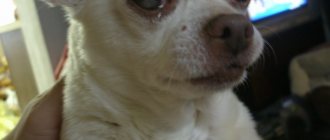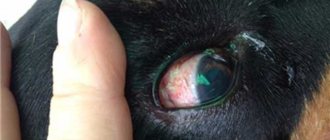Due to the structure of the skull and the shape of the eyelid, pugs often suffer from eye diseases. Tears, redness, and swelling are alarming and make you frantically look for ways to help your pet before visiting the veterinary clinic.
What eye diseases exist in dogs of this breed? What should you buy in your home medicine cabinet? When is it better not to delay visiting a doctor? Read our article!
Home care
You should start monitoring the condition of your pug's eyes 10 days after his birth. It is then that his eyes begin to open, and are visible from under the raised eyelid from the inner corner. The immunity of ten-day-old puppies is not yet strong enough, and if a nursing mother has conjunctivitis, it is likely to be passed on to the offspring.
Important! If your female pug has eye problems, treat them before treating her with a cable. This way you will prevent the possible development of diseases in future offspring.
You can keep your pug's eyes healthy by regularly following these rules:
- Check the corners of your eyes for dirt every day, especially after walking, and wipe them with a damp cloth.
- Monitor the state of lacrimation. If your eyes begin to water intensely or, conversely, become dry, this is a reason to consult a doctor.
- Make sure that while walking, litter, dust and sand do not get into the pug’s eyes.
- Make sure that the pug is not exposed to the wind or draft for a long time.
- Make sure your veterinary medicine cabinet is full so that you always have the necessary medications at hand.
What to wash and drip with?
If you are the owner of a pug, make sure that your veterinary medicine cabinet always contains the following medications:
- physical solution;
- chloramphenicol;
- tetracycline ointment;
- antiallergic drugs (tavegil, suprastin);
- tsiprovet.
Almost all of the above pharmaceuticals can be purchased at a regular “human” pharmacy. Having them at hand, you can be sure that, if necessary, you will be able to provide first aid to your pet and alleviate its condition before a medical examination.
How to wipe?
The pug's eyes are round and quite large. Due to their specific shape and the dog’s small stature, debris and dust regularly settle in them. You need to wipe your pug's eyes at the same time every day. This way you will accustom the dog to the necessary “ritual” of cleanliness, and he will not experience stress and resist.
Remove accumulated mucus with a cotton pad soaked in boiled water or saline solution, moving in the direction from the outer corner to the tear duct.
Important! Normally, a pug's eyes are slightly moist. Tears should not flow from them, nor should they be excessively dry and faded.
Red squirrels
There may be three reasons why a pug’s eyes may be red:
Conjunctivitis
An inflammatory process caused by pathogenic bacteria or viruses entering the mucous membrane. With bacterial conjunctivitis, the eye becomes red and purulent discharge appears; with viral conjunctivitis, slight clear mucus appears.
Bacterial damage to the organs of vision should be treated with antibacterial drops and ointments. Perfect for this purpose:
- Tsiprolet;
- Phloxal;
- Levomycetin (drops);
- Tetracycline (ointment).
In case of a viral infection, it is enough to rinse the eyes with saline. solution until improvement occurs. If after 5 days of intensive treatment there is no improvement, be sure to visit a veterinarian.
Keratitis
With keratitis, redness of the eyes is accompanied by attacks of photophobia. The dog constantly closes its eyes in the light, and sometimes cannot open its eyelids at all.
Reference! In pugs, keratitis develops due to the growth of the nasal fold. Increasing in size, it begins to touch and damage the cornea of the eye.
In the early stages, the disease can be treated with medication under the supervision of a doctor. As it progresses, keratitis can lead to loss of vision or the vital need for surgical removal of the eye.
Entropy
Entropy is a disease caused by the appearance of an extra fold on the eyelid (most often the upper one). The eyelashes curl inward and put pressure on the eyeball. The disease can be detected only at six months of age and later. In particularly difficult cases, the problem is solved by surgical shortening of the eyelid.
Conjunctivitis
Conjunctivitis is an inflammation of the mucous membrane of the eye that covers the inner surface of the eyelids (conjunctiva).
Conjunctivitis can be: follicular, bacterial, allergic.
Symptoms:
- With follicular conjunctivitis: the conjunctiva becomes red, with the formation of characteristic multiple follicles (microbubbles), which are usually clearly visible to the naked eye on both the inner and outer surfaces of the third eyelid.
- With allergic conjunctivitis: the conjunctiva is red, often swollen (edematous), lacrimation or mucous, mucopurulent discharge to varying degrees, often redness around the eyes, local itching, blepharitis (inflammation of the eyelids) with alopecia (baldness) around the eyes.
Treatment:
Depends on the causes of conjunctivitis:
1. Preliminary rinsing of the eyes in the presence of mucous or purulent discharge with a solution of chlorhexidine 0.05%
2. Local preparations with antibiotics;
3. Local and systemic antiallergic drugs;
4. For allergic conjunctivitis - search and, if possible, eliminate the allergen.
============================================================================================================================================================================================
Tears
Here are some reasons why your pug may be crying and blinking non-stop:
- Keratoconjunctivitis. Inflammation and increased lacrimation are caused by insufficient secretion of eye mucus and drying out of the apples. Treatment is selected by a veterinarian on an individual basis.
- Bringing debris into the eye - during a walk, sand or debris could get into the dog's eye, which causes irritation and tears. Carefully inspect your pet's eyes and if you find debris, thoroughly rinse the eye with physical water. solution.
Diagnostic methods
The veterinarian collects a detailed medical history. The owner should talk about the behavior and well-being of the pet recently, remember what preceded the pathology: stress, excitement, fight, illness.
Tell your veterinarian if you observe:
- itching (the dog rubs its eyes with its paw);
- corneal clouding (frequent blinking);
- inflammation, swelling in the eye area;
- discharge from the lacrimal duct, the presence of pus in it;
- increased lacrimation;
- asymmetry of the pupils;
- nature of the pathology (vascular network, redness of the eyelids, ulcerative lesions).
Pay attention to the general condition of the dog: body temperature, activity, appetite.
During diagnosis, a veterinarian-ophthalmologist examines the dog, assessing the condition of its eyelids and eyeballs. If glaucoma is suspected, tonometry is performed, measuring eye pressure.
The Schirmer test helps to exclude dry keratoconjunctivitis. It is designed to determine the amount of tear fluid secreted. The presence of microtraumas is also checked using a special fluorescent lamp.
To identify or exclude infectious pathologies or hormonal imbalances, a general blood test is performed. If necessary, an ultrasound examination is prescribed, which allows you to determine the presence of organic changes and complications of the disease (clouding of the lens).
If retinal detachment is suspected, an examination of the fundus and the condition of the optic nerve is performed - ophthalmoscopy.
Fester
Suppuration and sticky yellow-green crusts on the eyes are a sign of conjunctivitis that has developed as a result of a staphylococcal or streptococcal infection.
In the initial stages, you can get rid of the disease yourself by washing with saline solution and instilling antibiotic eye drops (Levomycetin or Floxal). In the absence of drops, you can use tetracycline ointment.
The procedure must be repeated three times a day. If there is no improvement on day 5, contact your veterinarian. He will select more effective treatment methods for your pet.
Why did the spots appear?
If your pug has strange spots on its eyes, you should not hesitate to visit a doctor. The cause of the disease in most cases is pigmentous keratitis. Pugs are susceptible to this disease for a variety of reasons:
- turning of the eyelids;
- trichiasis;
- districhiasis;
- dry eye syndrome;
- lagophthalmos.
Pigmentous keratitis requires intensive treatment under medical supervision. If the disease is left to chance, the dog may go blind or lose an eyeball.
Prevention
The owner must take responsibility for the health of his pet. To do this, it is necessary to conduct a preventive eye examination, preferably in the morning. Do not walk in areas with tall grass and tough bushes. Avoid injury and fights with other dogs on the playground. And also carry out hygienic trimming of claws in a timely manner, prevent the contact of cosmetics during washing, and exclude the animal from staying in drafts.
By following all measures to prevent eye diseases in pugs, you can be confident in your pet’s health. But no one can feel completely protected from injury. Therefore, you need to carefully monitor your dog’s health.
Similar articles
Cloudy film and eyesore
A cloudy eye, as if covered with a whitish film, in most cases is a consequence of injury. Only a veterinarian can accurately determine the cause and extent of the damage, as well as select the appropriate treatment. In most cases, treatment with antiviral, wound-healing or antibacterial drops is prescribed.
If the consequences of the injury are not treated in a timely manner, an incurable thorn will form on the eye, which will affect the pet’s visual acuity.
Pus from the eyes in dogs: the main thing
- examine the dog, determine the possible cause of the discharge;
- carry out hygiene and cleanse your eyes of all discharge;
- if you see an obvious pathology - for example, a foreign body, try to remove it;
- if a dog’s eye is festering and you cannot determine the cause, treatment should be prescribed by a doctor, try to show your pet to a specialist as soon as possible;
- Protect your eyes from additional injury by wearing a collar.
What to do if you are injured?
In pugs, like other brachycephalics, the eyes are injured very often. If you notice that the eye is red, watery and swollen, consult the contents of your veterinary medicine cabinet. Levomycetin or tetracycline ointment will help relieve signs of inflammation, and eye drops will reduce tearing on the damaged cornea.
Reference! In some cases, large debris may get into the eye, which, sinking into the folds of the eyelid or tear ducts, causes severe discomfort to the pet. It can only be obtained using a special medical instrument in the veterinarian’s office.
Symptoms
Epiphora is the most basic clinical symptom. In this condition, owners observe the animal's fur under the eyes becoming wet from excess tears, often brown or reddish in color.
It looks like the pet is “crying.” In fact, the tear that should have entered the nose through the nasolacrimal duct from the eye simply flows out onto the fur, turning a different color due to oxidation on oxygen. The reasons why this can happen are discussed above.
Blepharospasm is squinting of the eyes. Often, when there is damage or trauma to the ocular surface, the dog squints the eye and lacrimation intensifies as a protective mechanism.
Symptoms also include: redness of the eyes, scratching, cloudiness, the eye has become blue, white, gray, or increased in size, and the appearance of purulent discharge.
Bulging
Pugs have a rather specific skull structure due to which their eyes are essentially protected only by their eyelids. Severe stress, old age, weakened immunity can lead to eyeball loss.
It is quite difficult to confuse this phenomenon with something else. The pet looks scary - its eyeball looks huge and protrudes from its socket. It is covered with small vessels and is very watery.
The owner’s main task in this situation is to calm down and do everything possible to preserve the health of the animal. Act clearly and quickly, following the following instructions:
- Rinse the eye generously with saline. solution.
- Secure a sterile napkin on it with a bandage.
- Take your dog to a veterinarian immediately or call a doctor at home.
The specialist will set the eye back in place and tell you what care the animal will need in the future.
Strabismus
Strabismus, or strabismus, can occur in dogs of all breeds and ages. As for pugs, strabismus often occurs due to birth trauma. Accordingly, if the pathology is congenital, there is no need to do anything about it, since the dog does not experience discomfort or visual disturbances.
But it also happens that the cause of strabismus is a skull injury or an infectious disease. In this case, the possibility and need for treatment is selected by the doctor individually - this could be chemotherapy, a course of antibiotics or surgery.
Diseases of the cornea
Keratitis is a disease of the cornea of the eye. The most common types of keratitis in dogs are: Suppurative superficial keratitis. Vascular keratitis. Purulent deep keratitis. For more information about keratitis, see our article – Eye diseases in dogs.
Red eyes in a dog can be caused by:
- Violation of the blood clotting process.
- Tumors, including malignant ones (oncology in dogs).











